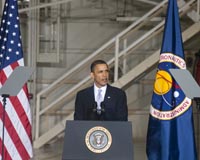 |
Washington (UPI) Jun 29, 2010 Advanced science and technology industries worldwide will have new opportunities in an overarching space policy unveiled by President Barack Obama as part of his strategy to boost investment and speed economic recovery. The policy precedes an anticipated end of the space shuttle program this year and exploration of closer U.S.-Russian collaboration, including American use of the Russian Soyuz program for transport to the International Space Station. A U.S.-led development of a commercial launcher is in the cards but may not materialize for another four years. The National Aeronautics and Space Administration will seek partnerships with the private sector to develop new technologies for human space travel, including commercial spaceflights to the ISS. NASA hopes to send people to new space destinations by 2025. NASA Administrator Charles Bolden, Jr. said the new policy backed the agency's historical role of researching and developing new launch systems but also required it to embrace new roles, including programs that created more jobs. NASA will have its budget boosted by $6 billion over five years and the resulting expenditure on new programs will create 2,500 jobs in Florida by 2012. NASA's plans include developing a low-Earth orbit transportation for manned craft. Central to the new policy is Obama's invitation to industries and nations worldwide to join hands in public-private partnerships. "Over the past 50 years, America has led the world in space exploration, broadening humanity's horizons and our understanding of the universe," Obama said in a statement. "And our achievements have in turn led to incredible technological advances that have improved our lives and transformed our economy. "We can point to satellites orbiting hundreds of miles overhead that can identify our location within inches, or communications systems that allow information to flow around the world as never before. "In part, what has made this progress possible was a commitment by our nation to scientific discovery and technological innovation, and an unyielding faith in the future -- even during difficult times," Obama said. He said the new space policy was "designed to strengthen America's leadership in space while fostering untold rewards here on Earth." Obama said, "Our policy reflects the ways in which our imperatives and our obligations in space have changed in recent decades. "No longer are we racing against an adversary -- in fact, one of our central goals is to promote peaceful cooperation and collaboration in space." With the budget deficit continuing to impede government spending, Obama said he would encourage cooperation "to the greatest extent practicable" in space science and exploration, Earth observation and climate change research. He said the United States will seek partners in space to improve and share environmental data, information leading toward disaster mitigation and surveillance of space for debris. NASA already has joined hands with the National Oceanic and Atmospheric Administration to contain the Deepwater Horizon oil spill in the Gulf of Mexico. NASA experts have used infrared imaging, satellite and computer modeling technology to monitor oil spewing out since the April 20 disaster. NASA also has applied its expertise to monitor earthquakes and their effect on the Earth and oceans. The agency predicted the size of the tsunami that resulted after the Feb. 27 earthquake in Chile.
Share This Article With Planet Earth
Related Links Space Tourism, Space Transport and Space Exploration News
 Obama lays out new US space policy
Obama lays out new US space policyWashington (AFP) June 28, 2010 President Barack Obama on Monday laid out an overarching new US policy on outer space, calling for more international and private sector cooperation on exploration, climate change and orbiting debris. The release of the new policy did not contain new, specific announcements, but served as a blueprint for government departments and foreign governments on US goals and philosophy on space explo ... read more |
|
| The content herein, unless otherwise known to be public domain, are Copyright 1995-2010 - SpaceDaily. AFP and UPI Wire Stories are copyright Agence France-Presse and United Press International. ESA Portal Reports are copyright European Space Agency. All NASA sourced material is public domain. Additional copyrights may apply in whole or part to other bona fide parties. Advertising does not imply endorsement,agreement or approval of any opinions, statements or information provided by SpaceDaily on any Web page published or hosted by SpaceDaily. Privacy Statement |